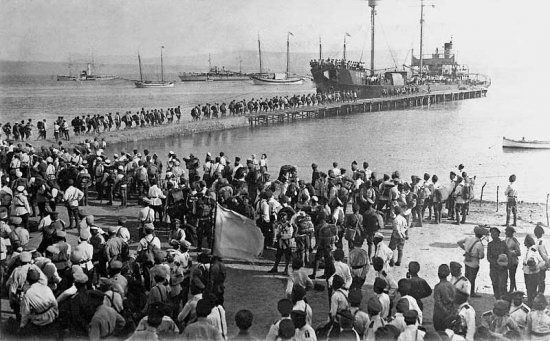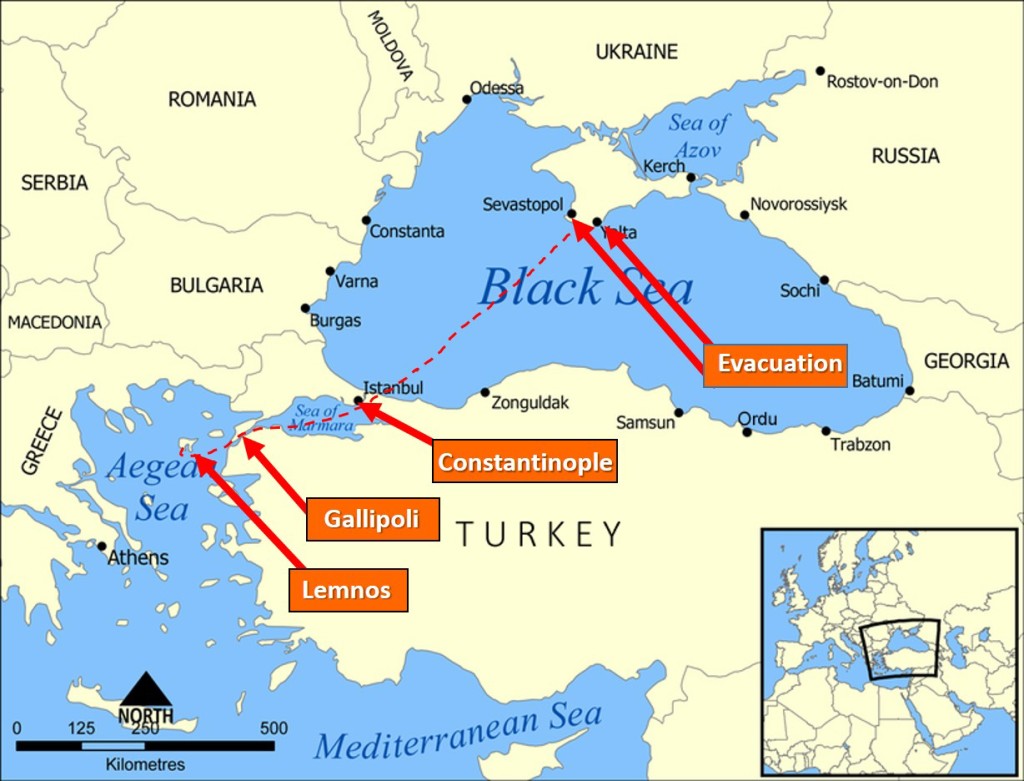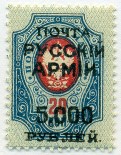ALBUM – View my Wrangel’s Army album
TRANSITION CHART – Ukraine and South Russia
Fast Facts
Region: Russia Area
Group: Ukraine and South Russia
Classification: Revolution
Prior Regime: Crimea, White Army Control
Key Dates:
1920, Apr 3 – General Wrangel assumes command of White forces in South Russia
1920, Aug 14 – France officially recognizes Wrangel’s Army in South Russia
1920, Nov 15-26 – Wrangel’s Army evacuates Crimea
1921, Apr 19 – France withdraws recognition of Wrangel;s army as an independent state.
1923, May 6 – the Last Refugees leave Gallipoli
Following Regime: none
Scott Catalogue: (Russia, Offices in the Turkish Empire) 232 – 376
Pick Catalogue: (South Russia) S420-S460
History

For much of 1919, the White Army in the south, under the leadership of General Anton Denikin continued to expand territory, uniting various factions against the Bolsheviks. However, the tide turned, when the Red army decisively defeated Denikin in October and November of 1919. Over the next few months, the weakened white forces began to retreat south, eventually consolidating in Crimea.
Early in 1920, Denikin was forced to resign and General Pyotr Nikolayevich Wrangel (known to the Bolsheviks as the Black Baron) was appointed as the new commander on April 4th. By this stage, however, Bolshevist’s superiority was overwhelming and further defeats lead Wrangel to organize a mass evacuation of military and civil personal from Russian soil. Beginning on November 15th, about 125 ships, most from the UK, USA and France evacuated Wrangel’s soldiers, their families and others fearing persecution from the advancing Red Army. More than 100,000 refugees were taken from Novorossijsk. and Sevastopol. The evacuation was complete on November 26th as the Red Army took over Crimea. The Bolsheviks summarily shot all of the dock workers who aided in the evacuation.
The ships split up and unloaded refugees in Constantinople (civilians), Gallipoli (Wrangel’s soldiers) or the island of Lemnos (Kuban Cossacks). Lemnos was used as a staging place for relocating the Cossacks to other places such as Serbia and Tunis. The largest concentration of refugees was in Gallipoli, which is where the bulk of Wrangel’s soldiers were taken. The soldiers continued to plan ways they could re-enter the fight against the Soviets. For a time, “Wrangel’s Army” was recognized by France as a legitimate government, and they maintained their own senate and leadership structure, oversaw their own banking and postal service.
The international community grew concerned about having such a large concentration of experienced soldiers in Turkey, especially as they still had aspirations of retaking Russia from the Communists. On April 19th, 1921, France withdrew their recognition of Wrangel’s Army as a separate state, and the allies began the process of relocating the refugees, settling them in Europe and the Balkans. The last group of Russians left Gallipoli in May, 1923.
Wrangel lived in Constantinople until 1922 when he relocated to Tunis, then Yugoslavia and finally to Belgium. In 1928, he died suddenly, probably poisoned by a Soviet agent.

Stamps
 ALBUM
ALBUM
As soon as refugee camps were established, Wrangel organized a postal system for military and civilian refugees. For stamps, the refugee post took stocks of stamps brought from Russia and surcharged them with new values for use within the camps. The stamps were considered legal, primarily because of their official recognition by the French. Additionally, the postal system in the collapsing Ottoman Empire was so unreliable that most foreign governments in the region issued their own stamps as well.
The first stamps were surcharged with new values and overprinted “Почта // РУССКОЙ // АРМiИ” (Post of the Russian Army) in blue, red or black. The stamps were surcharged in 1920-21 by E. M. Essayan in Constantinople on stamps from Imperial Russia, Russian PO’s in the Levant, Ukraine and Denikin’s Army in South Russia. More than 100 different types exist, primarily because Wrangel’s stock only had small quantities of each of the different stamps.
A second surcharge was printed in February, 1921, which is much more controversial. The second series of stamps were surcharged and overprinted “РУССКАЯ // ПОЧТА” (Russian Post) in blue, red, black or brown. The stamps were primarily printed for sale to the philatelic market for speculators and to aid the refugees, However, apparently for about 3 weeks in April, they were available in the refugee camps, making them legitimate postage stamps.
All stamps of Wrangel’s Refugee post were withdrawn for use on June 1st, 1921 as postal authority was revoked, and the refugees began to be relocated.
Overall, the Wrangel Refugee Post surcharges were applied to about 190 different varieties of stamps and have been extensively reprinted both in Constantinople and Paris.
Banknotes
During the Russian Civil War and the collapse of the Imperial Russian banking system, there were scores of entities, including white armies, which issued their own currency and banknotes. Most of the White Generals (Kolchak, Denekin, Avalov-Bermondt, and others) issued currency and banknotes for areas under their control.
When General Wrangel took over the White Armed Forces in South Russia from Denikin, he also took over the banking as well. His government issued banknotes in 1920 in South Russia for his area of control. After the evacuation, the currency continued to be used in Refugee camps, at least until the French withdrew their official recognition of Wrangel’s Government in April of 1921.
Links
VIDEO – Documentary: Wrangel, Russians deprived of Russia – part 1
VIDEO – Documentary: Wrangel, Russians deprived of Russia – part 2
VIDEO – Documentary: Wrangel, Russians deprived of Russia – part 3
Pyotr Wrangel from Russiapedia
The Crimea Left behind in Palls of Smoke – by Kirill Alexandro
Banknotes of South Russia (including Wrangel’s Army) from ATS Notes





Michael- As one has come to expect from your posts, a superb presentation. Thank you for fleshing out the complicated South Russia history- and nice stamps!
Thanks Jim
Don’t have time to work on these as I would like, but if I can continue to put out one or two a month, I am happy.
Cheers
Michael